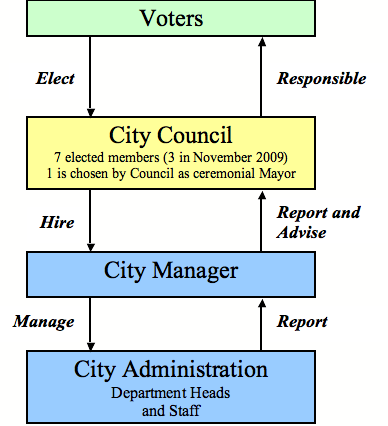
Did you know that in 1993, the City of Kingston adopted (by a landslide) a City Manager form of government? This is a great old article that helps us to understand what happened back then and also how we ended up with a strong mayor form of government.
Thanks to Tom Benton and Ulster Publishing for allowing us to repost this article.
How Kingston got its ‘strong mayor’
Commentary by Tom Benton
(originally printed in the KINGSTON TIMES)
This is how it actually went down, nearly 20 years ago. I should know; I was there. In fact, in a way I was caught up right in the middle of it all, though that was not my intention.
Some time around 1992, Kingston Mayor John Amarello got to thinking that the city’s charter, which hadn’t been modified since the late 1800s, could use a little updating. Maybe it was those provisions prohibiting displays of magic and legerdemain (sleight of hand) on city streets that got him thinking, or the ones dealing with where horses could be tied up. In any event, the mayor decided that it would be useful for someone to take a look at the charter to see if some modernizing might be in order.
And so it was that he decided to create a Charter Revision Commission to tackle the task. John — I knew him well enough to call him by his first name — approached me about acting as chairman of the committee. At the time, I was a young attorney practicing in Kingston, very much involved with various civic groups and friendly with many of the business and governmental figures in town. And best of all from the mayor’s standpoint (or so I believe now), I had no political axe to grind. I have never sought or held elective office (unless you count student council in high school) and had no aspirations to do so then. So I think the mayor felt that I would be somewhat free from the rough-and-tumble of local, partisan politics. If I may say so, they don’t get more fractious anywhere than they do in Kingston (with the possible exception of the recent debt ceiling imbroglio in Washington).
With some reservations about the time commitment it would involve, I signed on, so to speak, along with a half-dozen or so other local appointees. Significantly, one of those original members was then-Alderman T. R. Gallo, who resigned from the commission after several meetings (more about that later). We set about our work at frequent evening sessions, studying the charter of Kingston along with those of other similarly sized small cities. As it happened, I was also then the president of the board of directors of the Ulster County Chamber of Commerce. Some chamber members I knew believed that the “city manager” form of local government was preferable to the traditional model, theoretically being more efficient and business-like, and they encouraged me to introduce that concept into our discussions.
A brief overview of the “city manager” form: Traditionally in the U.S., most governments, be they state, county, city, village or town, have followed the federal model, wherein three branches (executive, legislative and judicial) regulate the entity’s affairs. This structure is designed to provide checks and balances on the uses and potential abuses of power. By the beginning of the 20th century, progressives started to wonder whether all that power-balancing was really needed at the smaller and more local levels of government. Couldn’t the legislative body (city council) just hire an executive to conduct the administrative affairs of the community? After all, the council has its own internal checks and balances built in by virtue of its multiple members. It was also thought a hired executive, with specific training and expertise, would provide better and more efficient operation than might be expected from an elected mayor who, well-liked and popular though he or she might be, usually has no real training for the job.
I don’t remember the number of meetings we had, but in the course of many weeks, a consensus began to build in the direction of the “city manager” form. I believe that this was about the time Mr. Gallo bowed out. Be that as it may, after months of meetings and many hours of discussion and debate, the commission ultimately finalized a proposed revised charter for the City of Kingston, incorporating the city manager concept. This was submitted to the city for consideration and potential adoption.
During the spring and summer of 1993, the charter revision commission held a number of public information meetings throughout the city, so residents would have the opportunity to learn about the new proposal. These were well-attended and aroused great interest and passion on both sides. In due course, and in accordance with the required procedure, Kingston’s Common Council approved the submission of the proposed charter revision to the local board of elections so that it could be placed on the ballot as a referendum item to be voted on in the fall of 1993. Supporters of the measure conducted an aggressive grass-roots campaign, handing out flyers door-to-door in Kingston neighborhoods and taking out ads in local newspapers. On Election Day, the revision was approved.
Those of us who had been active in the revision process, including prominent local business figures like Frank Bailey, George Hutton, George Bell and others, were celebratory. But it should be admitted that there was no certainty about how well the “city manager” form of government would work in Kingston. The “city manager” form had been quite successful in some cities — Austin, Texas, for example — but arguably less so in others. And the work of transition still lay ahead, as the new charter structure was to take effect in January 1995.
As it happened, the 1993 vote also brought about the defeat of the incumbent Republican mayor, John Amarello, by the Democratic candidate, T.R. Gallo. It was no secret that T.R. had long dreamed of becoming Kingston’s mayor. His late father was a fixture in Kingston politics two decades earlier. The new charter preserved the office of mayor, but significantly reduced his or her official duties and authority to what might fairly be characterized as “ribbon-cutter in chief.” This was far from what the newly elected mayor had envisioned for himself.
After a few weeks, then-alderman-at-large, James Sottile, responsibly formed an ad hoc committee to work on the transition process and to begin the search for a city manager. Because of my past involvement with the new charter, I was invited to participate in that group as a citizen member at meetings throughout the winter of 1993-94. Some time in the spring, word began circulating in Kingston about a new proposal which would supplant the recently adopted city manager charter by providing for a so-called “strong mayor” — an elected mayor with greater authority than is traditionally found. The document itself soon surfaced as Mayor Gallo began a public petition campaign to place the new charter revision proposal on the 1994 ballot as a referendum item.
To place a referendum on the ballot (an alternative to the mayoral commission procedure) requires the signatures of certain percentage of the affected voting public. Even for a mayor as popular as T.R. Gallo, this was a large undertaking, particularly in the turbulent wake of the previous year and a half of charter debates. As for the proposal itself, it was rather ingeniously constructed by taking the newly adopted charter and merely replacing the words “city manager” with “mayor” throughout. There were some other modifications, of course, but that was the essence of it. And here was the effect: Under the adopted charter, the city manager was given very broad and powerful executive authority, the governmental check on that authority being control and supervision by the Common Council. Under the new proposal, an elected mayor would have the same broad authority, but would be entirely free from any such control or supervision by the council. Strong mayor, indeed!
By late August, it appeared that the petition campaign would fall short of the required number of signatures. With time was running out to meet the filing deadline for the fall vote, Mayor Gallo hastily created a his own charter revision commission, whose appointed members immediately adopted the new “strong mayor” proposal without discussion or debate. A single public information meeting (a half-hour in duration) was held a few days later at City Hall and in short order, the “strong mayor” charter was submitted to the board of elections for placement on the ballot. As I recall, all of this took place in the space of less than two weeks.
With Election Day looming, there ensued an intense period of public debate and a visible war of lawn signs. Things took a turn toward the uncivil. At a public information meeting sponsored by The League of Women Voters, I was loudly and aggressively heckled throughout my presentation by a small group of partisans. Such was the tone and tenor of the time.
Many Kingstonians will remember the outcome. In one of the largest voter turnouts in city history, the “strong mayor” charter revision was passed into law. Although the margin of victory was narrow (around a hundred votes, as I recollect), the city manager charter adopted a year earlier was consigned to history without ever having been tried and the era of the strong mayor was ushered in.
Disappointed as some of us were, we all moved on. But the city manager issue has recently resurfaced in comments by some Kingston mayoral candidates. Knowledge of historical precedent can be instructive, so perhaps the foregoing will be useful to some. For others, it might merely be an interesting story. I do note that the county has recently changed to an “executive” structure. If Kingston does decide to revisit the city manager concept, it is hoped that the residents display the political will to give it a fair chance the second time around.
Tom Benton is a retired attorney who owns and operates the Tom Benton School of Music in Woodstock.

